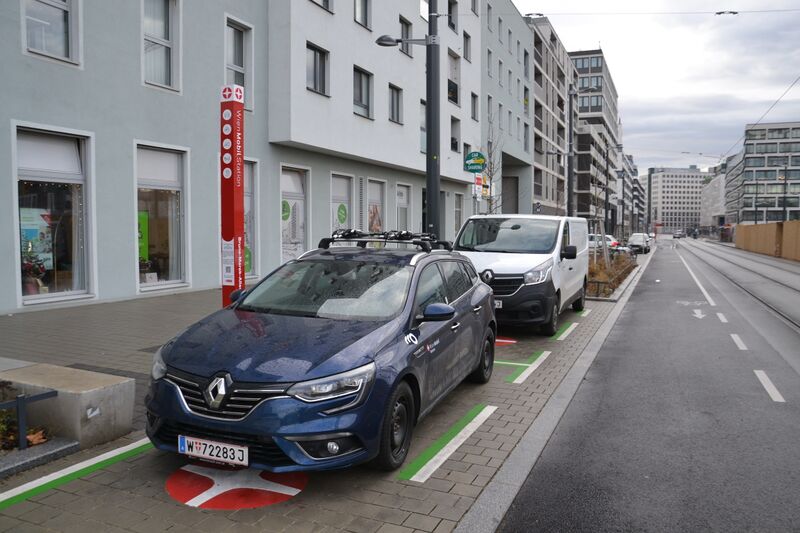
housing-based, decentralized hub, with carsharing, bikesharing and PT nearby
Mobility Hub in new urban area, with an audience with a very high sharing affinity . Car sharing vehicles are located in public space, other vehicles (bikes, cargo bikes,..) are located on a semi- private location. Station is organized by Wiener Linien (public transport operator) and partly operated by MO.Point (private sharing operator for all kind of vehicles)
2020
Reservation and booking only through the MO.Point App (App of Operator), public transport only via WienMobil App. Information about vehicles in printed and digital version. Information in word and pictogramms- easy to understand the usage. Intuitive reservation and booking process.
24h service hotline availableprivate company initiated
Bike parking, PT stop (quite distant),
local
brownfield development in central location, middle - high income inhabitants in surrounding area, 49 - 271 cars / 1000 inhabitants
Governance
1,900,000 in 2021
1,900,000 in 2021
City of Vienna (Municipality)
Local Administration:
- see regional administration
2. District Leopoldstadt
- District Head (Alexander Nikolai, SPÖ)
- District Council
Local Public or Private Stakeholders:
- see regional stakeholders
- Neighbourhood Management Nordbahnhofsviertel (NBV)
Local Networks:
- Working Group Mobility Stations
- Climate Council Vienna
- Eurocities, POLIS
- UITP (Wiener Linien)
City Administration ('Magistrat'), Unit for Innovation, Urban Planning and Mobility
- MA18 Urban Development and Planning, MA21 City District Planning, MA 28 Road Administration and Construction, MA46 Traffic Organisation and Technical Traffic Matters, MA67 Parking
- Executive City Councillor for Innovation, Urban Planning and Mobility (Ulli Sima, SPÖ)
- Deputy Mayor and Deputy Governor, Executive City Councillor for Housing, Housing Construction, Urban Renewal and Women's Issues (Kathrin Gaal, SPÖ), Executive City Councillor for Climate, Environment, Democracy and Personnel (Jürgen Czernohorszky, SPÖ)
- Wiener Linien, Unit for multimodal mobility planning
- MoPoint
- Urban Innovation Vienna (UIV)
- Mobility Agency Vienna
Federal Ministry for Climate Protection, Environment, Energy, Mobility, Innovation and Technology (Leonore Gewessler, Grüne)
Mobility plan as part of a strategic city planning process (STEP 2025)
- following SUMP guidelines of the European Commission
- targets objectives of 'Smart City Vienna Framework Strategy' (renewed into "Smart Climate City Strategy Vienna" in 2022)
Mobility requires human-scale and eco-compatible forms of transport. The City of Vienna is committed to prioritising public transport, pedestrians and cycling as the most environmentally friendly mobility modes. Vienna embodies a future-oriented urban mobility policy that is not only ecologically, but also economically and socially acceptable and hence sustainable.
Objectives: Fair, healthy, compact, eco-friendly, robust and efficient mobility system
Objective 36: Multimodal Stops:
- PT stops with added services
- Special attention to the design and surroundings of potential hubs (crucial: clear arrangement and barrier-free design)
- great potential for urban nodes with regional bus line connection & PT network of the region
Depending on needs, stops can be given added value, e.g. in the shape of: - bicycle parking facilities - bike-sharing systems - car-sharing spaces - kiss and ride zones
Smart City Strategy adjusted in terms of climate adaptation and mitigation Goals for mobility and transport sector:
- increase share of extended environmental allienace (PT, cycling, walking, sharing) up to 85% until 2030
- mobility guaranty (without private car use)
- 15-minute-city and redistribution of public space
- reduce private car ownership to 250 cars / 1.000 inhabitants by 2030
- reduce energy consumption by 40% and CO2 emissions by 50% per person by 2040
Vienna Climate Roadmap as a strategic planning document to achieve climate neutrality by 2040 Measures on mobility and transport:
- Avoid mobility and modal shift
- 15-minute-city
- Parking management and access regulation
- Expansion, densification and acceleration of public transport
- Expansion of walking and cycling infrastructure
- Support shared & on-demand mobility
- Logistic hubs
- Expansion of charging infrastructure (in public and private spaces)
- Price differentiation according to environmental impact